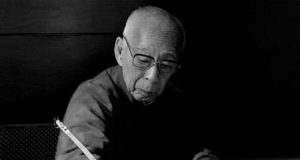
Just as a temple might be built, stone by stone, with a monk working physically, concentrating with one-pointed mindfulness on the laying of each stone, so the practice of meditation is developed and gradually built up in a series of repeated and successive actions, one by one.
In terms of everyday, conventional language, as a result of wrong view, we speak of temples and monks and bricks as though they were actually solid and permanently abiding objects.
In terms of ultimate reality (Pali: paramattha dhamma), there is, however, no concrete, abiding temple extant there. What we see is merely an aggregate of stones, built up one by one in a temporary arrangement and then gradually, as time passes, breaking down and deteriorating, fragment by fragment, until every thing will have turned into specks of dust and even smaller invisible particles, devolving into base elements of energy, ever dependently arising and ceasing, arising and ceasing, through a process which knows no beginning and no end.
In terms of actual reality, there is no monk either. What we call “he” or “him” is, similarly, just a process of changing elements within a wider process which, ultimately, knows no beginning and no end.
Someone might ask if it is a big undertaking to write a book on the Dhamma, but I would have to say that this is the wrong way of putting the question.
Just as a temple is only an aggregate of bricks and other materials, so a book is just an accumulation of words, sentences, and punctuation marks. Just as a monk, when working as a stonemason, consistently lays bricks one at a time, if an author, by comparison, happens to be writing a book by hand, he will draw each curl and loop and line of each letter of each word with one-pointed mindfulness, absorbed in a process of concentrated instants of energy, constantly arising and ceasing. Similarly, as he is organizing bits and dots and spaces into words, sequences, and paragraphs, one after another, relating parts of speech coherently together into sentences and paragraphs and essays, what he is creating will only amount to actions happening within a dependently arising ongoing process.
There will be no permanently existing paper either. What was once a tree becomes pulp and, then paper, and then, as time passes, even pages of paper will break down into minuscule particles and vibrations of energy, in the same way as everything else in the cosmos is conditioned. And so we see that all phenomena in Samsara are dependently occurring within an ever-changing and continuing process.
The quote: “There is no flag and there is no wind,” is often cited in Thailand and other regions of Southeast Asia. And in just the same way, ultimately, there is no writer, there is no book, there is no page, there is no paper, no wind, and no flag either. Every worldly phenomenon is just a happening, occurring instantaneously, in invisible increments, within an ever-wider, all-encompassing interrelated process of changing elements, arising and ceasing, arising and ceasing.
How mind energy should be understood, directed, and expended depends on right view and right intention, and it all begins with an understanding of a lack of (or emptiness of) any sense of an abiding corporeality or lasting existence.
When practicing the Four Foundations of Mindfulness, we start by focusing skillfully, concentrating on each thought-moment. We begin with the breath in the body, always present and easy to find, and this is why breath meditation plays such a basic role in Buddhist meditation.
The Buddha recommended mindfulness of breathing, explaining that such concentration, when developed and often practiced, is peaceful and sublime, affording an unadulterated blissful abiding, which stills and banishes unwholesome, unprofitable thoughts, as and when they are in the process of arising. Breath meditation, from the very beginning, assists in calming agitation and establishing tranquility. What makes the breath, when skillfully cultivated, so blissful and sublime is that when we are absorbed in such concentration, there is a lack of, and freedom from, any kind of mental unwholesomeness.
Being able to wrest the mind free of attachment to unskillful inclinations and actions will naturally depend on a gradual process of development of mental culture (Pali: bhavana). Firstly, the cultivation of virtuous conduct conduces to the relinquishment of greed and lust. Secondly, the equanimity of bhavana allows us to relinquish hatred. And thirdly, insight, based on right understanding and right meditation, evolves into wisdom, which assists mind-consciousness in recognizing and then dispelling ignorance.
Sati designates cultivating objective penetration through focusing with clear awareness. Sati means penetrating to the root-core of an arising feeling and seeing it the “way it really is” rather than “the way we would impatiently like it to be.” We realize that there is nothing lacking in a bare, original image, which would justify any sense of dissatisfaction based on greed and suffering. It is all about making the mind impervious to the harmful, unwholesome roots of craving, which are little more than selfish, delusional ego factors. It is about getting rid of the root causes of discontent based on ignorance, in order to avoid what would be consequent but wholly unnecessary suffering.
If we want to overcome and be free of mental impurities, we must develop the skills needed to liberate the mind from unskillful actions (Pali: kusala-kamma) arising due to three basic roots of evil translated as lust (Pali: lobha), hatred (Pali: dosa), and delusion (Pali: moha).
The Buddha taught that there is only one way for the purification of beings: through the Four Foundations of Mindfulness. There is no other way than by penetrating directly through: (i) the contemplation of the body; (ii) the contemplation of feeling; (iii) the contemplation of consciousness; and (iv) the contemplation of phenomena.
The Blessed One taught the one and only way to penetrate through wrong view, and that way was based upon the mind heedfully watching the intentions of the mind to see and regulate what mischief in which it might engage. In this kind of contemplation, the mind becomes the watcher, the observer, and the guardian against the arising of wrong intentions and harmful actions.
This necessitates that the mind be gradually and yet energetically trained, in order for heedful attention and mind power to become so sharp and so penetrating that such unhealthy root emotions, as attachment, hatred, and grief, will be readily recognized, skillfully decimated, and ultimately eradicated.
The seventh factor of the Noble Eightfold Path is called the “controlling” factor, and the Buddha in the Satipatthana Sutta instructs his practitioners that right mindfulness (Pali: samma-sati) needs to be present and active, carefully guarding and guiding each and every wholesome thought moment (Pali: kusala-acitta), and this manner of kusula-kamma ought to become the basis of all continuing, earnest endeavor (Pali: appamada) for the liberation, strengthening, and maintenance of the ardent energy needed as we keep striving to achieve purity on the path leading to the attainment of Enlightenment or Nibbana.
References
Nyanatiloka, Thera.1952. The Path to Deliverance, Kandy:Buddhist Publication Society.












